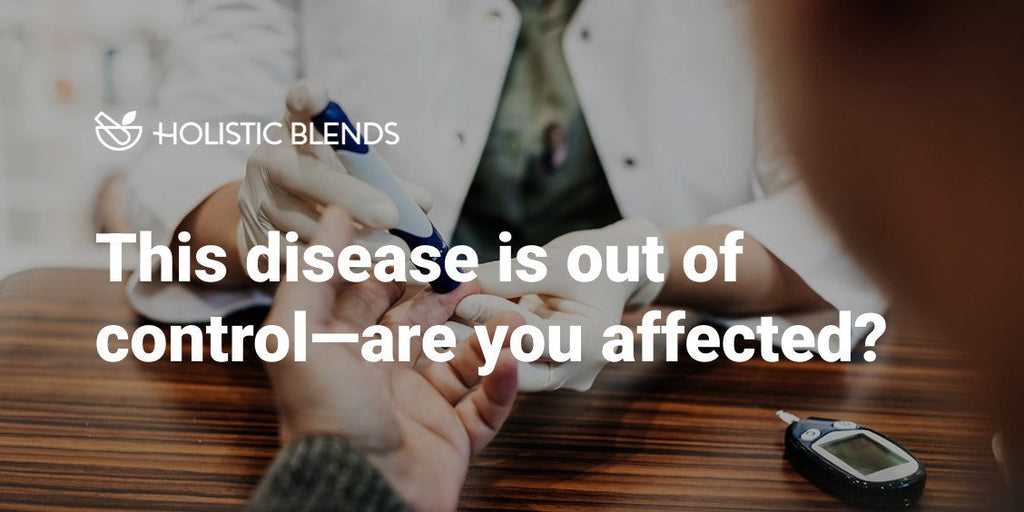Although heart disease and cancer still remain our top 2 killers, there is another disease that can affect your mortality and quality of life and it’s experiencing unprecedented, explosive growth.
Diabetes.
I remember when I was a kid in the 60s and 70s, diabetes was something that was relatively rare. One of my mother’s friends had it, and all I can remember is that she had to limit sweets.
Well, once the 80s hit, things started changing dramatically. Diabetes prevalence rose SEVENFOLD (i.e.: a 600% increase) in the 30-year period from 1983 to 2013 and it’s still going up!
Although the US population also grew during that time period, there was only a 34% increase.
It’s time to call this what it is—an EPIDEMIC—and do something about it!
The numbers
According to the CDC, currently about 38 million Americans have diabetes (with the overwhelming majority of those being Type 2), and another 98 million have elevated blood sugar levels (called prediabetes) and likely don’t even know it.
What in the world is happening?
Well, to answer that, you need to understand about blood sugar levels, what diabetes really is, and the many factors that are in the diabetes “recipe.”
Too much or too little
Blood sugar (glucose) is essential for all your body’s cells, especially your brain!
Maintaining proper blood sugar levels is crucial to your health and life, and any variances from “normal” ranges can have devastating consequences.
Blood sugar levels can be considered abnormal in two ways:
Hypoglycemia (too little)
Low blood sugar (hypoglycemia) is a blood sugar value of less than 80.
When your blood sugar plummets to between 60-80, you will feel shaky, jittery, anxious, sweaty, and confused. If it dips further between 40-60, these symptoms become more severe, and under 40 you may slip into a coma and die.
Thankfully, when your sugar level drops below 80, hormones come to the rescue--adrenaline helps make more glucose available to your cells, and glucagon helps convert fat into sugar.
Hyperglycemia (too much)
Elevated blood sugar (hyperglycemia) is a blood sugar value over 110.
Chronically elevated blood sugar can lead to heart disease, kidney disease, retinal degeneration/blindness, neuropathy, pain and burning in the extremities, foot ulcers/gangrene, and an elevated risk of infections.
Here too your body has a hormonal safety net (insulin) to reduce blood sugar levels…but some people have shortages, plus many others have been pushing the envelope with their pancreas’ insulin production for too long and are facing diabetes.
Diabetes = too much glucose + too little insulin
Type 1 diabetes is the less common type of diabetes, representing only 5-10% of cases.
With Type 1 diabetes, there is a problem with the pancreas, causing inadequate insulin production. Type 1 diabetes is frequently an autoimmune condition; plus, it can also result from damage to the pancreas from an injury or illness.
Type 2 diabetes is the form of diabetes that is exploding off the charts.
It’s all about supply and demand. Type 2 diabetes occurs when blood sugar levels are repeatedly higher than what your body needs to burn for energy.
This forces your pancreas to produce increasing amounts of insulin to bring your sugar level down, and eventually it may have trouble keeping up with the demand.
Insulin resistance adds a twist to this scenario. After repeatedly being barraged by insulin to absorb the sugar from your bloodstream, eventually your cells become like a saturated sponge, and they simply can’t take in any more sugar—a condition known as insulin resistance.
Note that unhealthy fats play a role here too. Excess consumption of linoleic acid, found in abundance in seed oils and processed foods, triggers inflammation and disrupts your cells’ insulin signaling pathways, making them less responsive to insulin and accelerating the development of diabetes.
Fight back and don’t become a statistic!
To fight back at Type 2 diabetes and avoid becoming a grim statistic, you must address the underlying issues, as well as support your body’s efforts to maintain proper glucose levels!
Here’s how:
Start with your diet
As much as people dread talking about their diets, you simply MUST acknowledge that diet is far and away the number one cause of the Type 2 diabetes explosion.
To prevent diabetes (and an early death), you should strive to avoid sugars, sweets, refined grains and starches, and seed/vegetable oils as much as possible.
This also includes beverages, especially soda, sweetened coffee and tea drinks, fruit juices, sports drinks and energy drinks.
Instead concentrate on proteins, healthy fats (like butter, olive oil, eggs, avocado and full-fat dairy) and non-starchy vegetables (all vegetables except potatoes and corn), and drink plenty of filtered water each day.
Say no to artificial sweeteners
I remember when my dear mother was in a nursing home prior to her passing, her roommate (Sadie) had diabetes, and I had the good fortune to be visiting one time when the home’s dietitian came in to check on Sadie.
In addition to telling her that she needs to be eating all her pasta (which, by the way, turns to sugar upon digestion—horrible advice for a diabetic), she also stressed the importance of using Equal® in her coffee instead of sugar.
I was speechless.
In addition to the mile-long list of serious health issues associated with artificial sweeteners, they also promote obesity by increasing hunger and motivating food consumption beyond satiety. And in turn, obesity also dramatically increases your risk of Type 2 diabetes.
If you want a calorie-free sweetener, try stevia.
Get sweatin’
Behind your diet, exercise is probably the second most dreaded topic for many people, but again you must face facts.
Regular exercise has been shown to help increase insulin sensitivity in your cells, which is exactly what you need to fight and reverse insulin resistance!
Pick the activity that’s right for you, get your doctor’s OK, put on those sneakers and get going!
Get enough sleep
Studies suggest lacking sleep can raise stress and blood sugar levels, encouraging insulin resistance.
If you have trouble sleeping, try drinking chamomile tea in the evening, avoid caffeine, sugar and alcohol near bedtime, take a warm bath with Epsom salts, and make sure your room is good and dark when you go to bed.
Note that regular exercise also helps here too! Exercise is one of the most effective stress-relievers in existence. Since poor sleep is often associated with high stress levels, exercise can help pave the way for better sleep.
Engage the power of turmeric
Research has shown that turmeric can help maintain proper blood sugar levels by increasing insulin secretion by the pancreas and supporting the absorption of glucose out of the bloodstream into the cells.
Let our Optimal Turmeric Blend help support your healthy blood sugar levels. Each 2-capsule dose provides 750 mg of pure turmeric plus black pepper extract for increased absorption.
Now you have an effective plan to reduce your risk of becoming part of the diabetes epidemic or help turn it around if you are already facing it!
To your health,
Sherry Brescia











